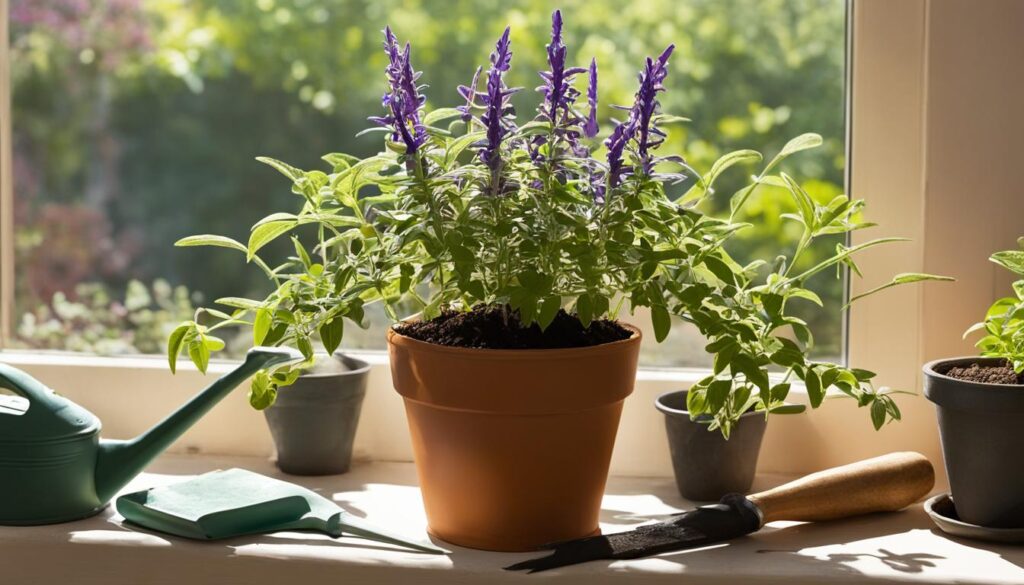If you have small spaces like patios, balconies, decks, or sunrooms, growing salvias in pots is a fantastic way to add vibrant blooms and aromatic beauty to your urban garden. Whether you’re a seasoned gardener or a beginner, this easy guide will walk you through the steps of successfully growing salvias in pots.
Salvia plants are adaptable and can thrive in containers as long as they receive at least 6 hours of full sun per day. This makes them perfect for urban gardens where space is limited. The best part? Salvias are relatively low-maintenance plants, making them an excellent choice for busy gardeners.
When it comes to choosing the right pot, opt for one that is at least twice the size of the salvia’s root ball. This will provide enough room for the plant to grow and develop a strong root system. Remember to ensure that the pot has sufficient drainage holes to prevent waterlogging, as salvias don’t like their roots to sit in wet soil.
The soil is another crucial factor in successfully growing salvias in pots. A 50/50 mix of compost and potting soil is ideal for providing the necessary nutrients and drainage. Aim for a pH level between 5.5 – 6.5 to create the perfect growing environment for your salvias.
Now that you have the basics sorted, it’s time to dive into the specific techniques for planting and caring for salvias in pots. Continue reading to learn the best soil and planting techniques for growing salvias in pots.
Best Soil and Planting Techniques for Growing Salvia in Pots
When it comes to growing salvia in pots, using the best soil and employing proper planting techniques are key factors for successful growth and vibrant blooms. With the right soil composition and attention to drainage, your potted salvia plants will thrive in any small space or urban garden.
To create the ideal soil mixture for potted salvia, combine equal parts basic potting soil and aged compost. This blend provides the necessary nutrients and promotes proper drainage, ensuring that your plants receive the right balance of moisture and oxygen. It’s important to choose a pot or planter with ample drainage holes on the bottom to prevent waterlogging of the roots.
To further enhance drainage, consider adding a thin layer of small stones at the bottom of the container before adding the soil mixture. This simple technique will help excess water escape and prevent root rot, keeping your salvia plants healthy and thriving.
When it comes to planting techniques, it’s essential to choose a pot size that accommodates the salvia’s root ball. A general rule of thumb is to select a pot that is at least twice the size of the root ball, allowing ample space for root development. Planting techniques may vary depending on whether you are growing annual or perennial varieties of salvia.
- Annual Varieties: For annual salvias, you can plant them outdoors after the last frost once the soil has warmed up. If desired, they can be brought indoors to a sunny location during winter to continue enjoying their vibrant blooms.
- Perennial Varieties: Perennial salvias can be planted in pots throughout the year, with extra care needed during the establishment phase. Ensure proper watering and protect them from extreme weather conditions during their initial growth period.
By focusing on soil quality, drainage, and proper planting techniques, you can create the optimal environment for your potted salvia plants to flourish. The next section will explore essential care and maintenance tips to further enhance their growth and ensure a bountiful display of beautiful blooms.
Care and Maintenance Tips for Growing Salvia in Pots
Proper care and maintenance are crucial for the successful growth of salvias in pots. To ensure their health and beauty, follow these care and maintenance tips:
1. Watering: The watering requirements for potted salvias depend on the weather and location. If you have outdoor potted salvias, they will primarily rely on rainfall. However, indoor potted salvias will need to be watered weekly or bi-weekly. It is important to keep the soil moist but not waterlogged.
2. Fertilizing: Fertilizing potted salvias is beneficial, especially after the initial planting phase. Feed your salvias with aged compost and replace the mulch regularly to provide them with the necessary nutrients.
3. Pruning and Deadheading: Pruning and deadheading are essential for maintaining the health and appearance of potted salvias. Prune perennial salvias in spring to encourage new growth and remove any dead or damaged stems. Deadheading, which involves removing faded flowers, promotes continuous blooms and keeps the plant looking tidy.
4. Winter Care: During the winter months, take extra precautions to protect your potted salvias. For annual varieties, bring them indoors where they can thrive in a suitable indoor environment. As for perennial varieties, insulate the pots to protect the roots from freezing temperatures.
By following these care and maintenance tips, your potted salvias will thrive and provide you with beautiful blooms throughout the growing season. Enjoy the vibrant beauty of salvias in your pots!
– Can the same method used for growing Salvias in pots be applied to cultivating cloves successfully?
Yes, the same method used for growing Salvias in pots can be applied to cultivating cloves successfully. Both plants require well-drained soil, ample sunlight, and regular watering. Additionally, it’s important to monitor for pests and diseases, and provide proper spacing for optimal growth. With proper care, growing cloves successfully in pots is very achievable.










